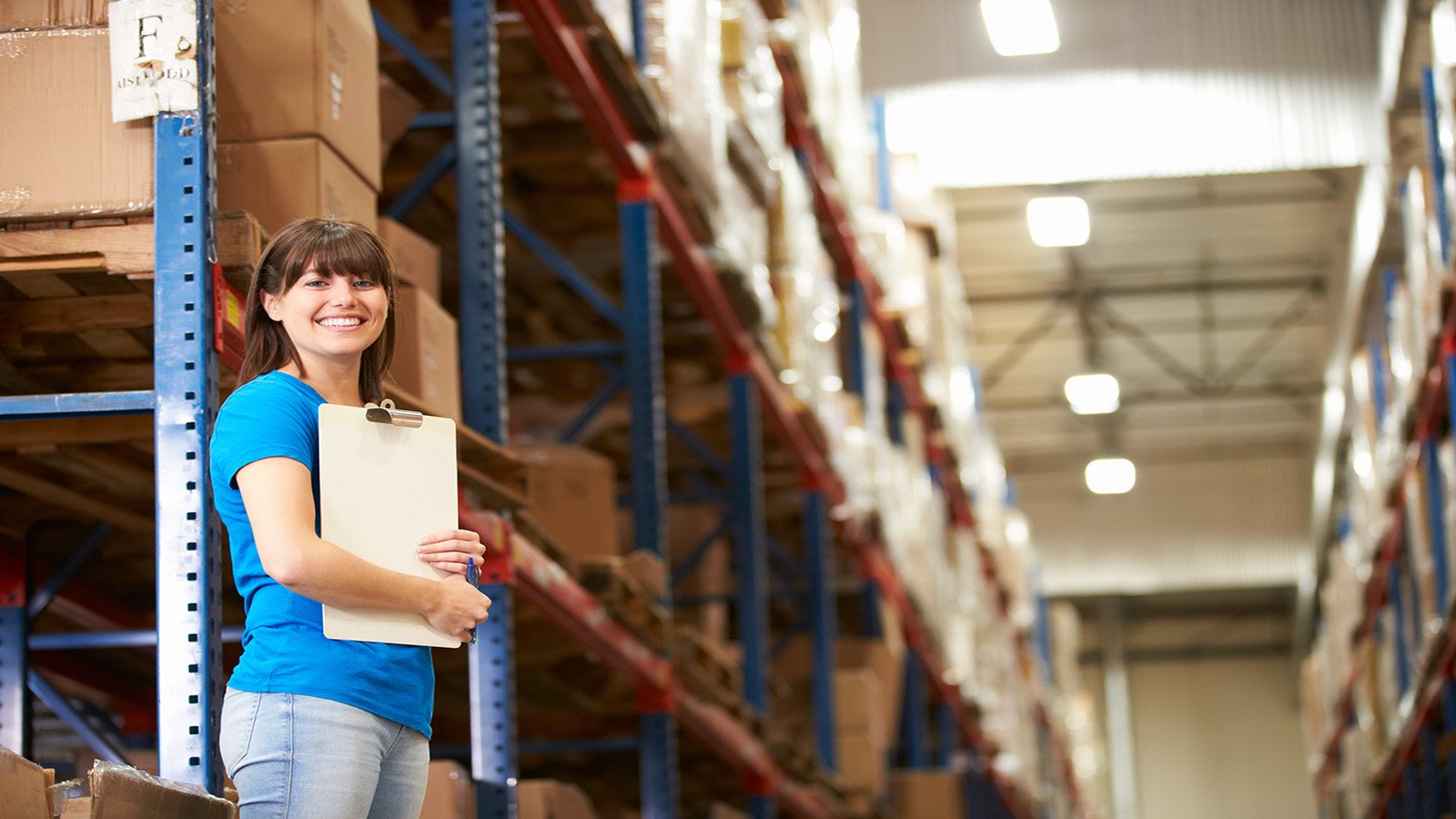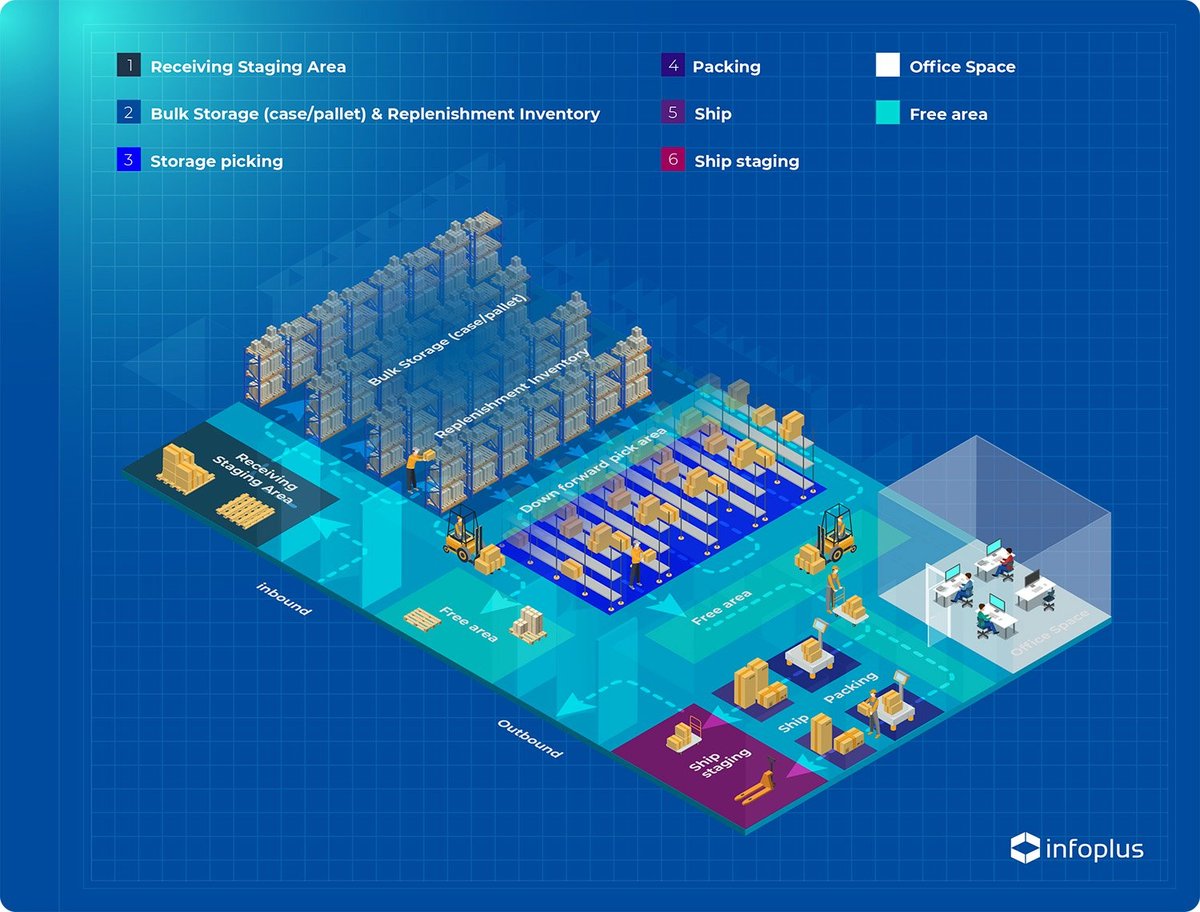Warehouse Set-Up 101: Optimized Medium Warehouse Layout

Medium-sized warehouses (~50,000 to 100,000 sqf) can be the “Goldilocks” solution for storage and logistics: big enough to avoid crowding (an issue for small warehouses), but not so big that your workers are forced to travel far or you waste floor space (which can happen in larger warehouses). The goal, then, is to get things “just right.”
Why? Every step a worker takes (and frankly every movement of a SKU) costs you both time and money. And while a typical medium-sized warehouse has all the same components as a smaller warehouse, the scale is much larger. So even though the complexity and “flow” of the warehouse are no more complicated than a small warehouse layout, you’ll have to work harder to make the layout streamlined and efficient.
That said, the exact size of the warehouse is not so important as the use. We’ll assume that you have volumes that support a larger space and that you have separate shipping and receiving docks. But it’s likely that you are not yet doing wholesale or value-added activities (like kitting).
An Ideal Warehouse Layout for a Medium Warehouse
A good medium warehouse layout will need to have these separate, specialized areas:
-
“Free” Areas
-
Storage
-
Down-forward Picking
-
Packing and Shipping
-
Receiving
Just as Goldilocks found all the comforts of home in the bears’ house, you’ve probably found that your medium-sized warehouse has more comfortable space for your growing list of products. But just like the heroine in the tale, you’ll need to test out different options to find out what is just right for you.

Reserve “Free” Areas for Future Activities
There are some activities that you will want to plan for as your business grows—for example, wholesale staging and value-added services. For now, you need to reserve some “free” areas for these activities without creating longer travel paths for your current operations.
Take wholesale shipping. You will need to prepare a separate wholesale area adjacent to your outbound dock door, but away from your current staging area. This will prevent your packing and shipping stations from getting “crowded out” while keeping smaller orders flowing. For now, though, that extra area by the dock door can stay clear without adding any extra “travel time” as your workers make their way through the rest of the warehouse.
You should also reserve some space for value-added activity stations. These are stations where you might need to perform steps not included in the typical packing process, such as:
-
Adding a pricing sticker
-
Subdividing bulk products
-
Assembling services
-
Kitting
-
Shrink-wrapping/stretch-wrapping/clam-shelling
Remember: you don’t need to decide right now exactly which activities you’ll need. You just need to reserve the space for the future. That reserved space should be somewhere between your forward picking locations and your packing stations. Just make sure that goods not needing these value-added activities won’t end up traveling much extra distance.
Choose the Right Storage Strategy for You
Arranging your storage area will involve trade-offs. Again, like Goldilocks, you’ll have to choose the setup that is “just right” for you.
For example, with all this new space you might be tempted to spread out your SKUs across shelving areas. This would give each SKU more space, which is useful if order velocity starts to increase and you need to store more of any given SKU. But it also forces your pickers to travel farther to get certain items during your restocking cycle.
The other option is to store all your SKUs as close to the down-forward picking area as possible (see below). This strategy reduces the travel distance while restocking and leaves space open for new SKUs. But it can’t handle increased inventory of existing SKUs without reordering your shelving area.
So, if you have a lot of inventory moving between storage and the down-forward picking area every night, it makes a ton more sense to store SKUs closer. If there is less movement, or if you anticipate growth in amount ordered for your SKUs, spread out.
(Note: this is a great argument for why you need good predictive analytics to foresee what your item velocity is going to be like day-to-day. The better that information, the more efficient you can be in stocking your down-forward picking area.)
Keep (Down-Forward) Picking Close to Outbound
Some products move quickly; others move slow. Few are “just right” in the middle. That’s why you need a separate down-forward picking area separate from your main storage area.
The down-forward picking area is where SKUs that are ordered more often—what we call “high-velocity” goods or orders—have daily order amounts set aside for easier picking. This way, all the items that need to be picked on a given day will be readily accessible in the closer forward picking area.
Everything else can go into long-term storage. Obviously, slower-moving items will have a larger percentage of goods in storage, while faster items will have a higher percentage in the down-forward picking area. This difference allows you to hit the “just right” balance when it comes to pick paths.
Every night (or whenever makes sense—you know your best schedule), there should be movement from the bulk storage area to the forward picking area, anticipating the goods that will be needed for the next day.
When it comes to overall placement in the layout, the forward picking area should be as close to your packing stations as possible to minimize travel time and maintain the flow of goods through the warehouse. (Yes, we’ve said that several times already. It’s important). You should be able to draw a single, linear path from the storage area to the down-forward picking area, and then on to packing and shipping. There should never be an instance where this path doubles back on itself—that’s a sign of an inefficient warehouse layout.
Set Up More Packing and Shipping Stations. Now.
As with any warehouse layout, shipping should be the main focus. Shipping product out the door is what grows the bottom line. And if that’s not happening efficiently, you need to address that first.
With more space, you will be able to incorporate more packing and shipping stations and increase the velocity of items going out the door. In fact, one of the worst things you can do is skimp on these stations. If you do, you’ll unwittingly create a bottleneck where items pile up. This pileup is a problem especially for SKUs needing extra attention because they are large, fragile, require light assembly, etc. Create a separate station (or several!) for these units so the rest of your orders can flow through without delay.
These packing and shipping stations should be located right next to the final outbound staging area. And in an ideal warehouse layout, that outbound staging area will be right next to the outbound dock door. That way, there’s a short, seamless flow from one area to the next.
Expect Busy Receiving
The more SKUs you have going out the door, the more you’ll have coming in as well. Hopefully, you’ve gotten a warehouse with two separate docks, one for inbound and one for outbound. Then the flow of goods in and out can be kept fairly constant, without one flow getting in the way of the other.
Remember, larger volume means you will have to keep things moving much more efficiently. Items should come off the receiving dock and immediately move to an adjacent receiving area and from there to bulk storage. This flow should never cross or interfere with your pickers going to and from other areas.
What If I’m Just Getting Started? Or Have a Lot More Areas?
Even a “Goldilocks” medium-sized warehouse needs to be well laid-out to be efficient. But, if you are just getting started, you might have a smaller warehouse with its own set of challenges, like a single dock and congested flow. We recommend you to check out Warehouse Set-Up 101: Optimized Small Warehouse Layout for a slightly different layout for that .
Likewise, you might have several of the above “value-added” activities. In that case, you should check out our optimal layout for a large warehouse.
And if you’re not sure which layout makes the most sense for your situation, let us know. We can help you assess your warehouse needs and get the layout that will best optimize your space.
.png?width=225&height=60&name=Logo%20(7).png)



